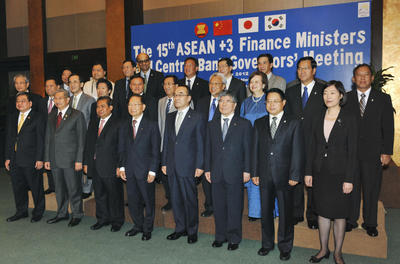A regional surveillance unit, the ASEAN+3 Macroeconomic Research Office (AMRO), supports the CMIM. But AMRO is still in its infancy, and will need time to increase its effectiveness and gain market confidence.
The CMIM is a self-managed reserve pooling mechanism of the ASEAN+3 economies, with a total size of US$120 billion. It provides a short-term (90 days) swap facility to economies in need, which may be rolled over a maximum of seven times (as of April 2012). Each economy’s swap quota depends on its contribution to the CMIM pool and its level of development and size. As with the CMI, using more than 20 per cent of a country’s swap quota requires a link to an IMF program. Voting weights for various countries have also been specified. A consensus is required for fundamental issues like membership, contributions and voting weights. And for a swap to be implemeted, a two-thirds weighted majority vote is required.
The CMIM still has many shortcomings and needs to be further developed to improve its effectiveness. First, the IMF link needs to be modified. The traumatic experience of IMF conditionality during the 1997–98 Asian financial crisis left a stigma on the IMF for most countries in East Asia. Because of this, when countries ran into foreign exchange liquidity shortages during the global financial crisis, they preferred to use bilateral swap agreements that had no IMF links rather than go through the CMI or the IMF. It is possible to develop the CMIM as a crisis prevention facility to deal with temporary liquidity shortages without linking to the IMF. When a country faces large temporary capital outflows, it does not make sense to impose IMF-like conditionality on the country; the CMIM’s 90-day swap should be available for the full quota without any links to the IMF. But if the country continues to need to roll over the swap, then the problem is more likely a medium-term macroeconomic structural problem rather than a temporary one. In such cases, it makes sense to link future rollovers to an IMF program. This arrangement would make countries more willing to access the CMIM swap and would also make the CMIM complementary to the IMF.
Second, the size of a country’s swap quota may not be adequate. One way to improve this is to double or triple the size of the CMIM. As the CMIM is a self-managed reserve pooling mechanism, economies do not place their contributions into a common pool. Rather, the reserves remain with the various economies, and a country’s contribution is only used if there is a swap drawing. So the actual cost of increasing the size of the CMIM’s reserve pool would not be that great. Another way to increase potential quotas available to countries would be to allow the addition of bilateral swaps from member countries linked to a CMIM swap. This would be similar to countries contributing to an IMF package.
Allowing the addition of bilateral swaps could also be used as a way to expand the number of countries involved in the CMIM process. Expanding the number of countries contributing to the CMIM pool would not be easy, as it would involve changes in voting weights and require a consensus among the current members. But countries such as Australia, New Zealand and India could be made ‘contributing partners’, where they can contribute their bilateral swaps to CMIM swaps. As contributing partners, they would also be allowed to participate in various financial cooperation activities under the CMIM umbrella, such as surveillance and initiatives to support deeper financial cooperation in the East Asian region.
Finally, for the CMIM to be effective, it is essential that AMRO becomes stronger and more capable. Building up AMRO’s capability and credibility is now the biggest challenge for increasing the CMIM’s effectiveness. AMRO needs to develop close links with other regional organisations, such as the Asian Development Bank and the ASEAN Secretariat. It should also have close links with international financial institutions, such as the IMF, the World Bank, the Bank for International Settlements and other monetary organisations around the world. In the longer term, AMRO should not simply act as a research office; it should evolve into a regional monetary organisation for East Asia, supporting the CMIM as well as carrying out technical activities to support financial cooperation in the region. This may include macroeconomic policy cooperation and coordination, a focus on regional financial regulatory frameworks and capital market development, as well as working to support the region’s longer-term financial and monetary integration.
Chalongphob Sussangkarn is a distinguished fellow at the Thailand Development Research Institute.


Didn’t CMMI get doubled in size with relaxed IMF linkage conditions at the ADB meeting earlier this month?
David Arase is correct. It is doubled to $240 billion.
But that aside, Sussangkarn raises a good point about potential contributing partners. Since China will not accept formal membership of Australia, NZ and India, an informal path may be a good start – if that is agreed upon by the APT membership each of whom have a veto. The question is, is being involved in the CMIM in this capacity better than just offering a bilateral directly to the country for Aus, NZ and India? It would depend on the specifics of the offer, and whether a more permanent seat could be on offer after the crisis which triggered the offer passed.